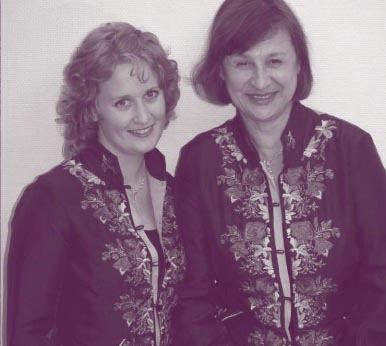 |
||||||||
 |
||||||||
 |
||||||||
Album Title: Mozart/Grieg - Works for Two Pianos Vol. II Performers: Dena Piano Duo Label and #: 2L SABD 57 (2-disc box: hybrid SACD/audio-only Blu-ray) Running time: 59'36" Recorded: August 2008 |
||||||||
| Unlike Vol. I which comprises four Mozart piano sonatas with accompaniment for second piano by Grieg, this album consist of only one work of that nature, the C minor Fantasia K475. The other two works are both original compositions for two pianos: Mozart's own K448 Sonata and Grieg's Old Norwegian Melody with Variations Op. 51. Dena Piano Duo, Norwegian pianist Tina Margareta Nilssen and her former Berlin Professor Heide Görtz, fascinate the audience with an even broader spectrum of colors on their musical palette. The purebred K448 will not disappoint the puritan Mozart community, only double their pleasure. The work is more demanding than most Mozart solo sonatas yet the Dena Piano Duo laughs in the face of technical and interpretive challenges. They do not metronomize themselves to sacramental rite but glide through the most difficult passages with natural fluidity and pulse. They do it so gracefully that I almost lose sense of their fast-paced tempi, which makes the experience simply more jaw-dropping. |
||||||||
|
The Fantasia being improvisational in nature provided Grieg with creative license to embellish at will then and the Dena Duo the liberty to interpret freely now. But like any world-class piano duos, they know only too well that freedom without discipline equals chaos. The two outer "Adagios" with their grave introductions are dramatic as well as romantic but never indulgent. The center-piece "Andantino" is exquisitely pensive but never whimsical, framed by the two "Allegros" that are tempestuous but never impulsive. This is perfect balance between freedom and discipline that wins your heart without coercion. |
||||||||
 |
The world premiere recording of Grieg's Op.51 was by piano duo Kjell Baekkelund and Robert Levin back in the early 80s [Ecetera KTC 1004]. It's a beautiful performance except for the thinner, brighter piano sound and for the two pianos being almost too distinctively separated. The 2L recording has the rich sonority and warm bass that makes pianos sound exactly like pianos. Whether in stereo or multi-channel mode, the two pianos maintain perfect proportion and relation to one another. So far I haven't heard one 2L SACD that failed to impress on sonic quality. My only regret is, until my Blu-ray player is here, I have nothing to report on the Blu-ray version. |
|||||||
|
* The 14 variations and finale are all grouped together in a single track without indexing. But you can still decipher where each variation begins. And I have a feeling that Grieg's stylistic assimilation was not always rigidly restricted to one composer per variation. Sometime he let two composers' |
||||||||
|
styles come together. Sometime he roamed freely from one style to another within the same variation, most noticeably in the "Finale". After I'd taken the musical quiz, I asked Morten Lindberg for the answers. He replied: "Your stylistic analogies would be just as qualified as mine as we have no documentation from the composer on this point. In Grieg's time there was no educational system for musicians and composers in Norway so they all went to Germany to study. Fascinated by central European culture, most 'Norwegian' music from the Romantic era is 'world music' inspired by our own local folklore, at the time mainly fiddle and vocal tradition." So, are you ready to take the quiz? Here is mine anyway. (00:00) Introduction |
||||||||
 |
||||||||